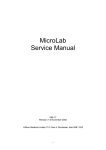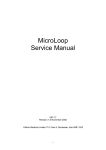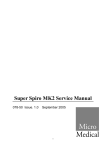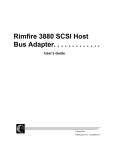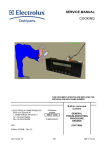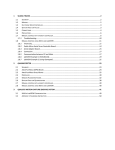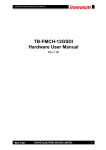Download NT Series Master Development System User's Guide
Transcript
NT Series Master Development System User's Guide ! Warning: Some customers may want Linx radio frequency (“RF”) products to control machinery or devices remotely, including machinery or devices that can cause death, bodily injuries, and/or property damage if improperly or inadvertently triggered, particularly in industrial settings or other applications implicating life-safety concerns (“Life and Property Safety Situations”). Table of Contents 1^ 2^ 2^ NO OEM LINX REMOTE CONTROL OR FUNCTION MODULE SHOULD EVER BE USED IN LIFE AND PROPERTY SAFETY SITUATIONS. No OEM Linx Remote Control or Function Module should be modified for Life and Property Safety Situations. Such modification cannot provide sufficient safety and will void the product’s regulatory certification and warranty. 2^ Customers may use our (non-Function) Modules, Antenna and Connectors as part of other systems in Life Safety Situations, but only with necessary and industry appropriate redundancies and in compliance with applicable safety standards, including without limitation, ANSI and NFPA standards. It is solely the responsibility of any Linx customer who uses one or more of these products to incorporate appropriate redundancies and safety standards for the Life and Property Safety Situation application. 5^ Do not use this or any Linx product to trigger an action directly from the data line or RSSI lines without a protocol or encoder/ decoder to validate the data. Without validation, any signal from another unrelated transmitter in the environment received by the module could inadvertently trigger the action. All RF products are susceptible to RF interference that can prevent communication. RF products without frequency agility or hopping implemented are more subject to interference. This module does not have a frequency hopping protocol built in. Do not use any Linx product over the limits in this data guide. Excessive voltage or extended operation at the maximum voltage could cause product failure. Exceeding the reflow temperature profile could cause product failure which is not immediately evident. Do not make any physical or electrical modifications to any Linx product. This will void the warranty and regulatory and UL certifications and may cause product failure which is not immediately evident. 3^ 3^ 4^ 5^ 6^ 6^ 8^ 9^ 10^ 13^ 13^ 14^ 14^ 15^ 15^ 16^ 16^ 17^ 17^ 18^ 19^ Introduction Ordering Information NT Series Transceiver Development Board Board Objects Initial Setup Troubleshooting The Prototyping Area The TX Power Select Switch The Transceiver Area The Power Area The Evaluation Area The Range Test Area The PC Control Area The PC Software Using the Boards as a Design Reference About Antennas Board Control Transmitter Output Power Selection Transceiver Area Header Section Range Test Area Power Area Evaluation Area LEDs Single Routing Online Resources NT Series Master Development System User's Guide Figure 1: NT Series Master Development System Introduction The Linx NT Series RF transceiver modules offer a simple, efficient and cost-effective method of adding wireless communication capabilities to any product. The Master Development System (Figure 1) provides all the tools necessary to correctly and legally incorporate the NT Series into an end product. The development boards serve several important functions: • Rapid Module Evaluation: The boards allow the performance of the Linx NT Series modules to be evaluated quickly in a user’s environment. Using the onboard transcoders, a pair of development boards can be used to evaluate the range performance of the modules. • Application Development: An onboard prototyping area allows for the development of custom circuits directly on the development board. All signal lines are available on a header for easy access. • Software Development: A PC interface allows for development and testing of custom software applications for control of the module. • Design Benchmark: The boards provide a known benchmark against which the performance of a custom design may be judged. The Master Development System includes two assembled development boards, four NT Series transceivers*, two CW Series antennas, two 9V batteries, four reverse polarity SMA connectors*, a USB interface board and full documentation. * One part is soldered to each board –1 – Revised 3/18/2015 Ordering Information Initial Setup Unpack the development system, attach the antennas and install a 9V battery on each development board. The boards can be used in two different configurations: Prototype and Evaluation. The Mode Selection switch sets the configuration. By default, the boards are set to Range Test in the Evaluation configuration. Ordering Information Part Number Description MDEV-868-NT 868MHz NT Series Master Development System MDEV-900-NT 900MHz NT Series Master Development System Evaluation Configuration Setting the Mode Select switch to the EVALUATION (right) position enables the Evaluation Configuration. In this configuration, the module’s signal lines are routed to the Evaluation Area for control. This enables the module to be configured by the controls on the board while allowing custom data to be sent over the link. Figure 2: Ordering Information NT Series Transceiver Development Board 5 4 6 2 Range Test The development boards feature an onboard Linx MT Series transcoder which facilitates range testing. Buttons on one board activate a light or buzzer on the other. A confirmation LED provides visual acknowledgment that a transmission was received across the wireless link. 7 1 12 8 3 13 10 9 15 11 16 14 17 Figure 3: NT Series Transceiver Development Board Board Objects 1. Prototype Area 2. Break-Out Header 3. RSSI Level 4. NT Series Transceiver 5. RP-SMA Antenna Connector 6. Module Power Header 7. Output Power Level Selection Switch 8. Evaluation Selection Switch 9. Baud Rate Selection Dial 10. Channel (Frequency) Selection Dial 11. Transcoder Range Test Area 12. PC Control Area 13. 9V Battery (on the back of the board) 14. DC Power Jack 15. Master Power Switch 16. Mode Selection Switch 17. Module Mode Indicator LEDs Range Test is part of the Evaluation configuration and is the default configuration out of the box. To use the boards this way, place the Mode Select switch to Evaluation and the Evaluation Select switch to the RANGE TEST (middle) position. This routes the DATA_IN, DATA_OUT and T/R_SEL lines to the MT Series Transcoder. Prototype Configuration Setting the Mode Select switch to the PROTOTYPE (left) position enables the Prototype Configuration. In the Prototype configuration, the module’s signal lines are routed to the break-out header next to the Prototype Area. This allows the module to be controlled with custom application circuitry. Software Development The kit includes one USB interface board for connection to a PC. Included software demonstrates use of the module’s Command Data Interface (CDI). Troubleshooting If the boards fail to work out of the box, then try the following: • Make sure that the Master Power, Mode Select and Evaluation Select switches are in the correct positions. The Active LED should be on –2 – –3 – • Make sure that the Baud Rate and Channel switches are set the same on both boards • Check that the antennas are connected • Make sure that a jumper is installed on the Module Power Header • Make sure that the batteries are not dead If all of these appear to be in order, please call +1 800 736 6677 or e-mail [email protected] for technical support. The TX Power Select Switch The board has a switch to select among three different transmitter output power levels (Figure 5). The right position sets the module to full power of about 12dBm. The center position sets the output power to about 0dBm, which is the legal limit for most applications. The left position uses resistor R37 to set the power. This position is an unpopulated 0603 size resistor location. A resistor can be placed here to set the output power to any available level. Please see the NT Series Data Guide for more information on resistor values. A power cycle is required for changes to take effect. The Prototyping Area In addition to its evaluation functions, the board may also be used for product development. It features a prototyping area to facilitate the addition of application-specific circuitry (Figure 4). The prototyping area contains a large area of plated through-holes so that external circuitry can be placed on the board. The holes are set at 0.100" on center with a 0.040" diameter, accommodating most industry-standard SIP and DIP packages. External circuitry can be easily interfaced to the NT transceiver through the breakout header (TS1) to the right of the prototyping area. The Mode Select switch should be set to the left position to enable the module’s lines to be controlled from the prototyping area. At the bottom of the prototyping area is a row connected to the 5V power supply and at the top is a row connected to ground. Note: The onboard 5-volt regulator has approximately 600mA available for additional circuitry. If more current is required, the user must add an additional regulator or power the board from an external supply. Figure 5: The Development Board TX Power Select Switch The Transceiver Area The transceiver section consists of the transceiver module and a reversepolarity SMA connector as shown in Figure 6. The RP-SMA connector is FCC compliant and reverses the center pin and socket. RP-SMA connectors will mate with but not provide electrical connection to standard SMA connectors or SMA equipped antennas. A header next to the module disconnects the module’s power from the main board power. This can be used for current measurements or to power the module alone from an external power source. A jumper must be installed to power the module from the board. Figure 6: The Development Board Transceiver Area Figure 4: The Development Board Prototyping Area –4 – – 5– The Power Area The Power Area has two switches that control power to the board and the type of operation (Figure 7). The Master Power switch supplies power from the 9V battery or the power jack to the board. The power jack accepts a 2.5mm plug with the tip ground and the shell 7 to 12VDC. The Mode Select switch configures the board for either Prototype operation (left position) or Evaluation operation (right position). In Prototype operation, the module’s signal lines are routed to the header next to the Prototype Area. This allows custom circuits to easily interface with the module. In Evaluation operation, the module’s signal lines are routed to the Evaluation Area. The controls in this area allow the module to be operated without any other circuits, microcontrollers or a PC. Three LEDs show the state of the module. Active shows the module is on and ready for operation. Standby and Power Down indicate that the low power modes have been entered and the module is not ready for operation. Figure 8: The Development Board Level Adjust Section The right position puts the module into receive mode. The yellow RX LED lights up and data received by the module is output on the yellow DATA_OUT test point. These two configurations allow the module to transmit and receive custom data while controlling the baud band and channel with the frequency dials on the board. It is similar to the Prototype Area, but requires less external circuitry to configure the module. The switches on the board are used for hardware configuration in this mode. The Baud Rate Control dial sets the BAUD0 and BAUD1 lines to configure the module’s baud band. This should be set the same on both boards for proper operation. Figure 7: The Development Board Power Area The Evaluation Area The Evaluation Area is activated by setting the Mode Select switch to the right position. Figure 8 shows the Evaluation Area. The Evaluation Select switch configures the area for different types of evaluation. The left position puts the module into transmit mode. The orange TX LED lights up and any data present on the blue DATA_IN test point is transmitted by the module. –6 – The Channel Control dial sets the CHAN_SEL0, CHAN_SEL1 and CHAN_SEL2 lines to configure the module’s channel. This should be set the same on both boards for proper operation. An LED bar is used to provide a general indication of the RF signal strength. The closer the active LED is to the top, the stronger the received signal level. The receiver must be active for at least one second for the RSSI level to update. The center position on the Evaluation Select switch activates the Range Test Area, allowing the link’s range to be evaluated. This area is described in detail in the Range Test Area section of this user’s guide. – 7– The Range Test Area The board features an MT Series remote control transcoder with two push buttons, a buzzer and an LED. The two boards in the kit are populated differently so that the button inputs on one board are outputs on the other board. Figure 9 shows the differences. Board A Board B Figure 9: The Development Board Range Test Section When a button is pressed on one board, the status of both buttons is captured, encoded into a data stream, and transmitted. The data recovered by the receiving board is decoded and the transcoder’s data lines are set to replicate the states of the buttons, driving either the buzzer or the LED. A confirmation packet is then sent to the transmitting board activating the Confirm LED. To achieve maximum range, keep objects such as your hand away from the antennas and ensure that the antennas on the boards have an unobstructed line-of-sight path to each other. Range performance is determined by many interdependent factors. If the range you are able to achieve is significantly less than specified by Linx for the products you are testing, then there is likely a problem with either the board or the ambient RF environment in which the board is operating. First, check the battery, switch positions, TX output power setting and antenna connection. Check the range performance on different channels. Next, measure the receiver’s RSSI voltage with the transmitter turned off to determine if ambient interference is present. If this fails to resolve the issue, please contact Linx technical support. The PC Control Area The PC Control Area is used with a daughter board to connect the module’s Command Data Interface to a PC. This advanced feature is a serial data interface for configuration and data transfer. One USB interface board is included with the development kit. Additional USB interface boards or an RS-232 interface board can be purchased separately. 1 1 2 2 To activate this area of the board, the module’s DATA and T/R_SEL lines must be routed to the transcoder. This is accomplished by setting the Mode Select switch to the right position and the Evaluation Select switch to the middle position. After the boards have been configured, place Board A on a flat surface and turn it on. Turn on Board B and press button S1. The buzzer on Board A will sound and the Confirm LED on Board B will light up. The usable range of the link in your environment can be ascertained by carrying Board B away from Board A. Switch SW11 has been provided to continuously transmit the LED activation without having to hold down a button. As you near the maximum range of the link in your area, it is common for the signal to cut in and out as you move. This is normal and can result from other interfering sources or fluctuating signal levels due to multipath effects. The areas in which this occurs are commonly called “nulls” and simply walking a little farther will often restore the signal. –8 – 3 3 4 4 Figure 10: PC Interface Boards The top DIP switch (1) controls the TRPT/PKT line on the module. This line selects between transparent data transmission and packet data transmission. Slide it to the left for transparent data and to the right for packet data. The bottom DIP switch (1) controls the CMD_DATA_BAUD line on the module. This is the data rate for the CDI and has no effect on the over-the-air data rate. Slide to the left for 57,600bps and to the right for 9,600bps. – 9– The three position slide switch (2) controls the CMD_DATA_TYPE line. This line tells the module that the data coming in on the CDI is either command data for configuring the module (middle position) or packet data to be transmitted over the air (top position). The bottom position connects this line to the DTR line on the USB or RS-232 interface. This allows the PC software to control the line, giving it the ability to configure the module and send data. Test points for CMD_DATA_IN (3) and CMD_DATA_OUT (4) are provided so that the communications can be monitored. The PC Software The kit includes PC software that can be used to configure the module through the PC interface daughter board. Figure 11 shows the software. The command portion of the window starts in the middle of the window (Figure 13). At the top is a box that states the product name, firmware version and serial number. Figure 13: Development Kit PC Software Below this is a selection that determines how the module is configured (Figure 14). Writing to RAM is faster, but the settings Figure 14: Development Kit PC Software are lost when power is cycled to the module. Programming to flash takes a bit longer (5ms/byte), but the settings are retained when power is cycled to the module. Below this are the configuration settings (Figure 15). These allow the software to change the channel, baud band, transmit and receive mode and the output power. By default the module looks to its hardware pins for these configuration settings, so software control must be enabled for it to take control. This is done by checking the Enable checkbox in each section. Figure 15: Development Kit PC Software The Channel configuration allows the user to select from among all 101 channels offered by the module rather than just the eight available with the hardware lines. A selection box shows the channel and a text box shows the channel’s frequency. Figure 11: Development Kit PC Software The Baud Band setting adjusts internal filters and other settings to set the transceiver’s maximum over-the-air data rate. The Baud Band section allows for the selection from among the four baud bands. The left side of the window contains labels that expand to show links to useful information (Figure 12). This includes the Linx Technologies contact information and links to the website for the latest product documentation and software updates. Clicking on these links opens the page in the computer’s default web browser. The Transmit/Receive Mode selection activates the transceiver’s transmitter or receiver. When the receiver is active the measured RSSI level is shown in the text box. Figure 12: Development Kit PC Software – 10 – The Output Power section allows the module’s transmitter output power level to be adjusted. The NT Series has 57 power levels that drop the power in approximately 0.5dB increments. The adjacent text box shows the approximate power. This is not a measured value, but an approximate value based on characterization of the modules. – 11 – The “Read Active Settings” button at the bottom (Figure 16) reads the existing configuration settings from the module and adjusts the values in the configuration sections based on the module’s current configuration. The right column in the window starts with the Profile section (Figure 17). Specific configuration settings can be saved as a profile and loaded into a connected module. This allows the software to be used in small-scale production lines for products that provide connection to the CDI. Using the Boards as a Design Reference Figure 16: Development Kit PC Software First, since a ¼-wave antenna is employed, the ground plane is critical to serve as a counterpoise. Application Note AN-00500 and AN-00501 provide additional details on how a ground plane affects antenna function. Figure 17: Development Kit PC Software Second, a ground plane suppresses the transfer of noise between stages of a product as well as unintentional radiation of noise into free space. Select the “New” button to create a new profile and give it a name. Set the configuration controls as desired and click the “Save” button to save the profile. Click the “Program” button to send the profile to the module. All of the profiles saved on the PC can be viewed in the drop down menu and sent to the module with the “Program” button. The “Delete” button removes the selected profile from the computer. The Serial Command section (Figure 18) provides the ability to send a specific packet to the module. Byte values are typed into the boxes to create the packet and the “Send Command” button sends the packet to the module. The ACK text box displays the module’s response. The possible values for each byte are shown in the table below the “Send Command” button. The “Restore Defaults” button (Figure 19) writes the factory default values to the transceiver. This is an easy way to restore the module to a known configuration. From a layout perspective, the master development boards included in this kit are quite simple, yet they illustrate some important techniques that can be incorporated into a design. The module’s mounting pads extend slightly past the edge of the part. This eases hand assembly and allows for better heat conduction under the part if rework is necessary. The use of a full ground plane fill on the lower side of the board serves three important purposes. Third, a ground plane allows for the implementation of a microstrip feed to the antenna. The term microstrip refers to a PCB trace running over a ground plane that is designed to serve as a 50-ohm transmission line between the module and the antenna. A microstrip is implemented on this evaluation board. The module’s data guide and a calculator available on the Linx Technologies website provide more information on the microstrip implementation and calculations. About Antennas The choice of antennas is one of the most critical and often overlooked design considerations. The range, performance and legality of an RF link are critically dependent upon the type of antenna employed. Linx offers a variety of antenna styles that may be considered for a design. Included with the development system is a Linx CW Series connectorized whip antenna that should be connected prior to using the kit. Despite the fact that the antenna is not centered on the board’s ground plane, it exhibits a VSWR of <1.7 and demonstrates the module’s best practical performance. Figure 18: Development Kit PC Software Figure 19: Development Kit PC Software – 12 – – 13 – TRANSCEIVER AREA PIC16F1938 PIC16F1938 GND 2 GND 5 GND 6 7 8 TRPT/PKT CS0 GND CS1 Transmitter Output Power Selection TRANSMITTER OUTPUT POWER SELECTION TRANSMITTER OUTPUT POWER SELECTION CS2 LADJ R30 NS/DNP NS/DNP SW10 R30 SW10 GND GND RDY NC0 GND GND R2097.6k 97.6k1%1% R20 R37 R37 NS/DNP NS/DNP 3 4 Figure 20: Board Control LADJ LADJ 1 GND T/R_SEL BAUD0 BAUD1 GND GND RSSI GND Figure 21: Transmitter Output Power Selection 9 10 11 TR1 ANT1 44 GND GND CONREVSMA001 1 43 ANTENNATRANSCEIVER RF AREA GND NC GND 1 GND NC 2 NC 3 GND GND 4 NC 5 NC 6 TRPT/PKT GND 7 CHN_SEL0 8 GND 12 9 CHN_SEL1 TRPT/PKT 13 CHN_SEL2 10 CS0 14 LVL_ADJ 11 GND 15 READY 12 CS1 16 NC 13 CS2 17 GND 14 LADJ 18 T/R_SEL 15 19 RDY BAUD0 16 20 NC0 BAUD1 17 21 GND RSSI 18 T/R_SEL 22 GND 19 TRM-XXX-NT BAUD0 20 BAUD1 Figure 22: Transceiver Area 21 RSSI TS1 1 22 GND GND 2 CS0_P Header Section 3 CS1_P 4 5 6 7 8 9 10 11 12 13 14 TR1 GND GND NC NC NC GND GND NC DATA_IN NC DATA_OUT GND NC NC NC GND 41 40ANTENNA 43 39 GND GND 42 38 NC DATA_IN 37 DATA_OUT NC 36 35 T/R_SEL CMD_DATA_IN 23 GND GND BAUD0 STANDBY BAUD1 VCC RSSI 1 41 40 GND 1 2 3 4 5 6 7 8 9 10 11 12 13 14 15 16 17 18 19 20 TRM-XXX-NT GND CS0_P CS1_P CS2_P RDY BAUD0_P BAUD1_P RSSI_P STDBY PDN T/R_SEL_P DATA_OUT_P DATA_IN_P VCC DATA_IN 36 J2 34 33 1 2 VCC VCCM R21 100K 35 VCC2 GND R22 VCC2 100K R21 100K 32 31 CD_BAUD R43 R22 VCC2 100K VCC2 CD_TYPE R35 GND100K VCCM 29 2.2K 30 CD_OUT 28 R36 GND 27 100K CD_IN 26 GNDGND GND TRPT/PKT CD_BAUD RDY CD_TYPE HEADER CD_OUT CD_IN C13 0.01uF R43 VCC STDBY 25 23 PDN J7 GND R35 2.2K R36 VCC2 VCCM C13 0.01uF GND 2 SECTION J7 GND GND TRPT/PKT CD_BAUD RDY CD_TYPE CD_OUT J8 CD_IN 1 2 3 4 5 GND 1 2 VCC2 J8 VCC GND 100KGND GND C14 100pF VCC 100K GND 1 J6 – 15 – 1 2 37 VCC2 DATA_OUT POWER_DOWN 1 2 3 4 VCC25 6 VCC 7 8 9 10 11 GND 12 13 14 15 16 17 18 19 20 J2 VCC GND VCCM GND HEADER SECTION 24 J6 RF GND GND 38 DATA_IN 34 ANT1 CONREVSMA001 GND 39 GND Figure 23: Header Section –14 – 44 GND GND DATA_OUT 33 NC TRPT/PKT NC 32 NC CHN_SEL0 NC 31 CD_BAUD CMD_DATA_BAUD GND GND 30 CD_TYPE CMD_DATA_TYPE CHN_SEL1 NC 29 CD_OUT CMD_DATA_OUT CHN_SEL2 NC 28 GND GND LVL_ADJ CMD_DATA_BAUD 27 CD_IN CMD_DATA_IN READY CMD_DATA_TYPE 26 STDBY STANDBY NC CMD_DATA_OUT 25 VCC GND GND 24 PDN POWER_DOWN GND NC CS2_P RDY BAUD0_P BAUD1_P TS1 RSSI_P STDBY 1 PDN 2 T/R_SEL_P 3 DATA_OUT_P 4 DATA_IN_P 5 VCC 6 7 8 9 10 11 12 13 14 42 GND 2828 PGD PGD 2727 PGC PGC 2626 PDN PDN 2525 STDBY STDBY 2424 TX_SEL TX_SEL 2323 RNG_SEL RNG_SEL 2222 RX_SEL RX_SEL VCC 2121 MODE_SEL VCC MODE_SEL 2020 1919 GND GND C7C7 1818 RX_LED RX_LED 0.1uF 0.1uF 1717 PDN_LED PDN_LED 1616 STBY_LED STBY_LED GND 15 15 ACTV_LED GND ACTV_LED 2-5 U11 U11 11 VPP RE3/MCLR/VPP RB7/PGD VPP RE3/MCLR/VPP RB7/PGD 2 2 RA0/AN0/SS RB6/PGC RA0/AN0/SS RB6/PGC 33 RA1/AN1 RB5/AN13 RA1/AN1 RB5/AN13 44 DACOUT/AN2/RA2 RB4/AN11 RB4/AN11 5 DACOUT/AN2/RA2 AN3/RA3 RB3/AN9 DATA_CTL1 5 RB3/AN9 DATA_CTL1 6 AN3/RA3 RA4 RB2/AN8 DATA_CTL2 6 RA4 DATA_CTL2 RB2/AN8 7 CH_BD_CTL 7 SS/AN4/RA5 RB1/AN10 CH_BD_CTL SS/AN4/RA5 RB1/AN10 88 GND VSS RB0/AN12/INT GND RB0/AN12/INT 9 VSS VDD TR_CTL2 9 OSC1/RA7 VDD TR_CTL2 10 OSC1/RA7 VSS TR_CTL1 10 OSC2/RA6 VSS TR_CTL1 OSC2/RA6 11 11 ALL_EN RC0 RX/RC7 ALL_EN RX/RC7 12 RC0 TX_LED 12 RC1 TX/RC6 TX_LED RC1 TX/RC6 13 RC2 PROTO_LED13 SDO/RC5 PROTO_LED SDO/RC5 14 RC2 EVAL_LED 14 SCL/SCK/RC3 SDA/SDI/RC4 EVAL_LED SCL/SCK/RC3 SDA/SDI/RC4 Transceiver Area GND BOARDCONTROL CONTROL BOARD 2-5 Board Control GND 1 2 3 4 5 C14 100pF GND Range Test Area Evaluation Area RANGE TEST AREA EVALUATION AREA R8 SW8 1 GND D1 B1 U1 GND AP1117E50G-13 1 3 Vin Vout SW1 J1 GND GND GND SW9 D1 B1 MODE_SEL GND VCC GND VCCM 2 PWRJACK GND GND SW9 MODE_SEL GND GND VCC TP1 VCC VCCM GND + C2 C1 220uF 10uF U10 4 3 S2 D2 GND R24 GND 5 2 G2 G1 10K 6 1 D1 S1 VCC GND VCCM 4 R24 10K 5 6 U10 S2 D2 G2 G1 D1 S1 DMG1016V GND PDN GND GND TEST POINT 1 TEST POINT PDN 2 GND LEDS CS2_S VCC NS/DNP R20 91k1% GND GND 82 C C 4 2 2.20K R29 1% GND R38 EVAL_LED 470 ohm R38 470 ohm R39 470 ohm D9 RED GND D3 RED GND GND ACTV_LED ACTV_LED R19 620 ohm 20 19 20 LED2 19 LED3 LED3 1 LED2 LED7 LED6 LED8 13 LED9 LED9 LED7 LED8 12 9 14 19 18 8 8 7 6 7 6 5 4 3 20 2 5 4 3 2 1 1 LED BAR 10 LED BAR 10 VCC VCC NS/DNP PDN_LED PDN_LED 9 10 16 17 15 16 14 15 17 18 10 2.2uF 11 20 RX_LED STBY_LED R41 200 ohm R40 470 ohmSTBY_LED R40 470 ohm D7 RED GND GND TX_LED TX_LED GND R25 200 ohm R25 200 ohm D4 ORANGE D4 ORANGE D2 GREEN GND GND – 17 – R26 200 ohm D8 YELLOW D7 RED GND R26 200 ohm RX_LED R41 200 ohm D2 GREEN GND CS1_S C6 VCC 19 R42 R19 620 ohm 1 4 14 13 15 14 16 15 17 16 18 17 18 LED4 LED6 D3 RED D9 RED GND 13 NS/DNP R42 2.20K EVAL_LED 1% CS1_S 5 12 D6 LED5 GND GND –16 – 3 14 11 LED5 Figure 27: LEDs R30 2 GND 64 C62.2uF VCC LED4 13 9 R29 GND Figure 25: Power Area 13 5 GND U5 LM3914V REF OUT 1.2K 1% R39 PROTO_LED470 ohm U5 LM3914V 12 IN DIVIDER LOW 5 DIVIDER HIGH IN 7 6 N/C DIVIDER HIGH 8 7 REF OUT N/C 4 6 PROTO_LED 1 LED1 2 5 R27 100k C GND DIVIDER LOW R28 1.2K 8 1% R28 GND C SW4 6 GND D6 LED1 4 RSSI_B 8 GND VCC 10uF RSSI_B GND 1 LEDS 12 LED10LED10 GND GND GND GND 4 10uF C5 TP2 VCC2 1 TEST POINT R27 100k TP5 4 CS2_S CS0_S BAUD1_S 5 2 GND RX_SEL SW4 1 CS0_S RNG_SEL GND 46 C5 VCC2 3 2 1 TEST POINT + DMG1016V 1 C LEDs 1 TP5 28 BAUD0_S TEST POINT GND 5 C Figure 26: Evaluation 3 Area GND 2 POWER AREA GND 41 2 GND Figure 24: Range Test Area Power Area C TX_SEL BAUD1_S 11 pF 31 BAUD0_S C SW5 6 2 V- GND GND 100K R32 5 16 ENC_SEL LATCH GND 0 ohm 6 LICAL-TRC-MT 15 BLUE SER_IO GND SEL_BAUD VCC 7 14 R31 100K CONFIRM MODE_IND 8 13 NS/DNP LED TR_PDN D2 D2 SW11 9 12 S0 BOARD A = NS/DNP D10 R33 VCC TR_SEL D1 T/R_SEL_R D1 R13 10 11 GND VCC D0D0 TR_DATA D0 GND DATA_MT R18 R32 200 ohm620 BOARD A = NS/DNP 0 ohm LICAL-TRC-MT BLUE R0 R4 SW-SMT-SPDT BOARD B = 0 ohm LED GND BOARD A = NS/DNP BOARD A = 0 ohm R34 LED SW11 BOARD B = 100K BOARD B = NS/DNP S0 BOARD A = NS/DNP D0 R33 VCC GREEN BOARD A = 0 ohm LED-0805-GRN NS/DNP D0 S1 BOARD A =VCC R18 BOARD B = NS/DNP BOARD A = NS/DNP 620 VCC D1 GND R0 R4 SW-SMT-SPDT BOARD B = 0 ohm U4 LED GND R1 R5 1 6 BOARD A = NS/DNP BOARD A = 0 ohm BUZZER GND DATA_IN_R R34 T/R_SEL_R IN NO 2 5 BOARDA B= = 100K BOARD NS/DNP BOARD BOARD NS/DNP A =B0=ohm D0 VCC DATA_MT VCC COM GREEN 3 4 BOARD B = 100K BOARD B = NS/DNP BOARD A = 0 ohm LED-0805-GRN GND DATA_OUT_R GND NC S1 BOARD A = NS/DNP BOARD B = NS/DNP S2 BOARD B = NS/DNP MAX4544EUT VCC D1 GND VCC D2 U3 R16 R1 R5 1 U4 14 VCC R6 R2 1 A 6BUZZER BUZZER GND DATA_IN_R T/R_SEL_R IN NO 100K LED GND 5 BOARD A = NS/DNP BOARD A = 0 ohm 22 VCC DATA_MT VCC COM13 F BOARD 100K A =BNS/DNP 3 A` 4 BOARDA B= = 100K BOARD BOARD = NS/DNP GND DATA_OUT_R GND NC R17 BOARD B = NS/DNP BOARD B = 0 ohm 3 12 B F` S2 BOARD B = NS/DNP MAX4544EUT S3 BOARD B = NS/DNP 10k 4 11 VCC D2 B` E U3 VCC D3 C4 R16 15 14 BZ1 10 BUZZER AC VCCE` R6 R2 R3 R7 AUD-S-BUZ-12MM-4K 100K LED GND GND BUZZER 13 9 0.01uF 2 6 A`C` FD BOARDA A= = 100K BOARD BOARD = NS/DNP BOARD 100K A =ANS/DNP R17 BOARDB B= = BOARD 0 ohm NS/DNPBOARD NS/DNP BOARD B =B0=ohm 37 12 8 B GND F` GND D` S3 BOARD B = NS/DNP 10k 4 11 CD4069UB B` E VCC D3 C4 BZ1 5 10 C E` R3 R7 AUD-S-BUZ-12MM-4K BUZZER POWER AREA GND 6 9 0.01uF C` D BOARD A = 100K BOARD A = NS/DNP BOARD B = NS/DNP BOARD B = 0 ohm 7 8 TP1 GND GND D` U1 VCC 1 CD4069UBSW1 VCC J1 VCCM AP1117E50G-13 1 3 TEST POINT Vin Vout + C1 + C2 TP2 220uF 10uF PWRJACK GND 8 V- D2 D1 D0D3 2 GND GND VCC RX_SEL SW8 1 10 R14 R31 100K NS/DNP R15 GND EVALUATION AREA 3 V+ 100K D3 GND SW5 + GND 100K R15 GND V+ D10 GND 20 19 18 17 16 15 1420 1319 1218 1117 + 100K 100K R11 R13 100K 200 R12ohm R14 GND D5 D4 D3 LATCH SEL_BAUD GND MODE_IND D5 D2 D4 D1 D0 D3 RNG_SEL 3 100K 100K R10 R12 GND GND GND 0.1uF U2 1C12 VCC 2 D6 3 VCC D7 GND 4 CRT/LRN 50.1uF ENC_SEL 6 U2 SER_IO 17 VCC CONFIRM 28 D6 TR_PDN 39 D7 TR_SEL T/R_SEL_R 10 4 TR_DATA DATA_MT CRT/LRN 100K 100K R9R11 GND GND GND + 100K R8 R10 GND GND TX_SEL C12 RANGE TEST AREA VCC + 100K R9 GND 9 N/C N/C 10 REF ADJ REF ADJ 11 SELECT MODEMODE SELECT GND D8 YELLOW D5 YELLOW GND GND D5 YELLOW Single Routing Online Resources SIGNAL ROUTING www.linxtechnologies.com If you have questions regarding any Linx product and have Internet access, make www.linxtechnologies.com your first stop. Day or night, the Linx website gives you instant access to the latest information regarding the products and services of Linx. It’s all here, including: C9 GND GND GND GND R50 NS/DNP BAUD1_P R51 NS/DNP BAUD1_S R52 NS/DNP RSSI_P GND R53 5.1M 1 U7 2 3 4 RSSI RSSI_B ALL_EN GND GND VCC 0.1uF 5 6 7 8 Y1 VCC Y0 Y Z1 X Z X1 Z0 X0 EN A VEE B GND C 16 15 BAUD1 14 BAUD0 13 R54 NS/DNP GND R55 NS/DNP GND BAUD0_P 12 BAUD0_S 11 10 C8 9 GND GND GND GND R45 NS/DNP R46 NS/DNP R47 NS/DNP 1 CS1_P CS1_S 3 CS2_P 4 CS2 5 CS2_S 6 7 GND 8 GND C10 TP4 DATA_OUT_P 10k 1 2 1 R57 10k DATA_OUT 3 4 GND DATA_OUT_R R58 10k ALL_EN GND GND GND 5 6 7 8 Y1 VCC Y0 Y Z1 X Z X1 Z0 X0 EN A VEE B GND C VCC 2Y2 1Y2 1Y1 2Y3 1COM 2Y1 1Y0 1Y3 GND A GND B 14 Manual and Software Updates • Latest News • Data Guides • Application Notes R49 NS/DNP CS0_S 11 GND • Knowledgebase GND • FCC Information CH_BD_CTL And much more. Be sure to visit often! 10 9 www.antennafactor.com The Antenna Factor division of Linx offers a diverse array of antenna styles (Figure 29), many of which are optimized for use with our RF modules. From innovative embeddable antennas to low-cost whips, domes to Yagis, and even GPS, Antenna Factor likely has an antenna for you, or can design one to meet your requirements. 16 15 R59 14 10k DATA_IN_R 13 12 9 GND 10k DATA_IN R61 DATA_IN_P GND 10k 11 10 GND R60 DATA_CTL1 by DATA_CTL2 C11 1 2 3 4 5 GND R48 NS/DNP CS0_P 12 GND GND CS0 13 SN74LV4052A ALL_EN CS1 1 0.1uF 2Y0 INH 15 VCC TP3 U8 2COM 16 MC74HC4053A GND R56 0.1uF U6 2 ALL_EN GND VCC GND MC74HC4053A R44 NS/DNP • CH_BD_CTL 6 7 8 VCC 0.1uF U9 2Y0 VCC 2Y2 1Y2 2COM 1Y1 2Y3 1COM 2Y1 1Y0 INH 1Y3 GND A GND B 16 15 14 13 12 11 10 9 VCC T/R_SEL_R R62 NS/DNP Figure 29: Antenna Factor Anetnnas GND T/R_SEL T/R_SEL_P R63 NS/DNP GND GND TR_CTL1 TR_CTL2 SN74LV4052A Figure 28: Single Routing –18 – – 19 – Linx Technologies 159 Ort Lane Merlin, OR, US 97532 Phone: +1 541 471 6256 Fax: +1 541 471 6251 www.linxtechnologies.com Disclaimer Linx Technologies is continually striving to improve the quality and function of its products. For this reason, we reserve the right to make changes to our products without notice. The information contained in this Data Guide is believed to be accurate as of the time of publication. Specifications are based on representative lot samples. Values may vary from lot-to-lot and are not guaranteed. “Typical” parameters can and do vary over lots and application. Linx Technologies makes no guarantee, warranty, or representation regarding the suitability of any product for use in any specific application. It is the customer’s responsibility to verify the suitability of the part for the intended application. NO LINX PRODUCT IS INTENDED FOR USE IN ANY APPLICATION WHERE THE SAFETY OF LIFE OR PROPERTY IS AT RISK. Linx Technologies DISCLAIMS ALL WARRANTIES OF MERCHANTABILITY AND FITNESS FOR A PARTICULAR PURPOSE. IN NO EVENT SHALL LINX TECHNOLOGIES BE LIABLE FOR ANY OF CUSTOMER’S INCIDENTAL OR CONSEQUENTIAL DAMAGES ARISING IN ANY WAY FROM ANY DEFECTIVE OR NON-CONFORMING PRODUCTS OR FOR ANY OTHER BREACH OF CONTRACT BY LINX TECHNOLOGIES. The limitations on Linx Technologies’ liability are applicable to any and all claims or theories of recovery asserted by Customer, including, without limitation, breach of contract, breach of warranty, strict liability, or negligence. Customer assumes all liability (including, without limitation, liability for injury to person or property, economic loss, or business interruption) for all claims, including claims from third parties, arising from the use of the Products. The Customer will indemnify, defend, protect, and hold harmless Linx Technologies and its officers, employees, subsidiaries, affiliates, distributors, and representatives from and against all claims, damages, actions, suits, proceedings, demands, assessments, adjustments, costs, and expenses incurred by Linx Technologies as a result of or arising from any Products sold by Linx Technologies to Customer. Under no conditions will Linx Technologies be responsible for losses arising from the use or failure of the device in any application, other than the repair, replacement, or refund limited to the original product purchase price. Devices described in this publication may contain proprietary, patented, or copyrighted techniques, components, or materials. Under no circumstances shall any user be conveyed any license or right to the use or ownership of such items. ©2015 Linx Technologies. All rights reserved. The stylized Linx logo, Wireless Made Simple, WiSE, CipherLinx and the stylized CL logo are trademarks of Linx Technologies.














